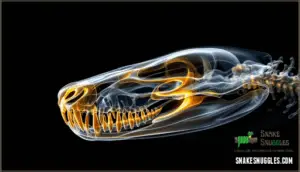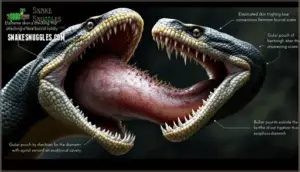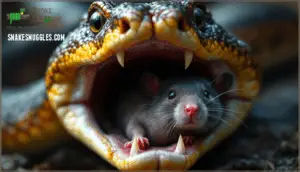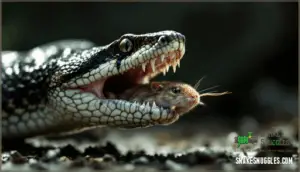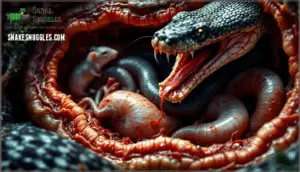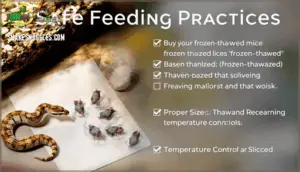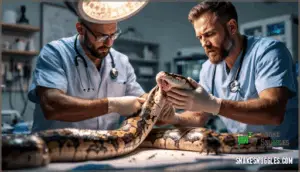This site is supported by our readers. We may earn a commission, at no cost to you, if you purchase through links.
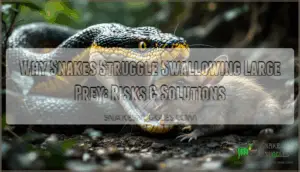
Understanding difficulty swallowing large prey snakes face isn’t just academic curiosity; it’s the difference between a successful feed and a veterinary emergency. The anatomy that allows these predators to consume whole animals also creates specific thresholds that, when crossed, transform an evolutionary advantage into a life-threatening liability.
Table Of Contents
Key Takeaways
- A snake’s jaw can stretch to six times its resting diameter, but prey exceeding the snake’s body width or weighing more than 10-15% of its mass triggers choking, regurgitation, or fatal impaction—transforming an evolutionary advantage into a life-threatening emergency.
- The quadrate bone and flexible ligaments work like a biological ratchet system, allowing each jaw half to "walk" forward independently around prey, while the glottis acts as a built-in snorkel to maintain breathing during swallowing.
- Species vary drastically in swallowing capacity—Burmese pythons can consume prey nearly 80% of their body mass with a 26-centimeter gape, while brown treesnakes max out at just 5.7 centimeters, affecting their prey preferences and ecological impact.
- Safe feeding requires matching prey diameter to the snake’s widest body section (not head width), maintaining proper temperature above 75°F for metabolic function, and seeking immediate veterinary care if you observe persistent open-mouth breathing, stuck prey beyond 24 hours, or repeated regurgitation.
Snake Jaw Anatomy and Swallowing Mechanism
You might think a snake’s jaw simply unhinges like a door, but the reality involves a complex arrangement of bones and ligaments working in concert. The quadrate bone, flexible mandibles, and stretchy skin all play specific roles in allowing snakes to consume prey that seems impossibly large.
Let’s break down how each component contributes to this extraordinary feeding mechanism.
Role of Flexible Ligaments and Quadrate Bone
Your snake’s jaw hinges on two key players: flexible ligaments that let the lower jaw halves move independently, and the quadrate bone—a mobile pivot point that swings the whole mechanism forward like a double-hinged gate.
This cranial kinesis lets each mandible "walk" forward alternately around prey, while elastic ligament flexibility prevents bone dislocation.
The quadrate movement creates a ratcheting effect, pulling food toward the throat with precision—a bone adaptation refined over millions of years.
Skin and Buccal Cavity Expansion
Once the jaws gain their grip, elasticated skin stretches like a living accordion—some species can expand their mouth opening to six times resting diameter, while the buccal cavity itself balloons outward to cradle prey that looks impossibly oversized. This skin elasticity comes from loose connections between overlapping scales and elastic tissues that form a flexible gular pouch beneath the jaw.
Your snake’s buccal capacity determines its true swallowing capacity—not jaw width alone—because the esophagus stretch and scale arrangement must accommodate prey diameter throughout the entire journey inward.
Swallowing Process and Glottis Function
As prey slides deeper, a small muscular tube called the glottis pushes forward from the floor of the mouth—acting like a built-in snorkel—so your snake can keep breathing even while its throat is completely blocked by a meal.
This respiration interplay prevents airway obstruction during bolus passage, though aspiration risks remain if regurgitation occurs unexpectedly.
Glottis protection is critical to swallowing mechanics—without this adaptation, your snake would suffocate before finishing its meal.
Prey Size Limitations and Feeding Challenges
Even with their jaw-stretching abilities, snakes face real limits on what they can safely swallow. Push beyond those boundaries, and you’re looking at choking, regurgitation, or worse.
Here’s what determines whether a meal goes down smoothly or becomes a veterinary emergency.
Maximum Safe Prey Size for Snakes
Your snake’s body diameter at its widest point sets the benchmark for safe prey selection—match that measurement, and you’ll avoid most swallowing disasters.
Here are the key Safe Ratios for appropriate prey size:
- Prey diameter should equal or fall below your snake’s maximum body width
- Prey mass shouldn’t exceed 10-15% of your snake’s total body weight
- Measure prey at its thickest point before offering
- Young snakes require smaller Prey Size Limits than adults
- Oversized prey beyond these Regurgitation Thresholds triggers serious Impaction Risks
Accurate prey measurement prevents dangerous feeding complications.
Risks of Oversized Prey (Choking, Regurgitation, Impaction)
When prey diameter exceeds your snake’s body width by even 10–20%, you’re inviting a cascade of life-threatening complications that can unfold within hours. Choking hazards arise when oversized prey blocks the glottis, causing airway obstruction.
Regurgitation follows if the esophagus can’t accommodate the meal, leading to internal injuries from repeated muscle contractions. Dangerous impaction occurs when boluses press against organs or the spine, creating death risks that demand immediate veterinary intervention.
Species Variations in Swallowing Capacity
Not all snakes swallow the same way—gape size and anatomical differences create vastly different prey size limitations across snake species. Burmese pythons stretch their jaws to 26 centimeters, consuming prey nearly 80% of their body mass, while brown treesnakes max out at just 5.7 centimeters.
Egg-eating snakes use extreme skin stretch to swallow objects five times their head width. The Gans’s egg-eater, for example, can achieve remarkable gape size relative to its body.
These feeding adaptations determine prey preference, feeding success, and invasive impact on ecosystems.
Digestion Process and Potential Complications
Once your snake swallows its meal, the real work begins inside. The digestive system faces considerable challenges when processing large prey, and things don’t always go smoothly.
Understanding what happens during digestion helps you spot trouble before it becomes a crisis.
Slow Metabolism and Energy Demands
Digestion in snakes is an energetically expensive process that can consume up to 25% of the calories in the prey itself, turning their stomach into a biochemical furnace that must break down tissue, bone, and cartilage over days or even weeks.
This slow metabolism means you’ll see dramatic shifts in their energy expenditure and thermal regulation needs:
- Metabolic rate can spike 7-fold during digestion, demanding sustained heat
- Energy economics dictate feeding frequency—some species eat monthly, not weekly
- Digestion time varies by prey size and temperature, ranging from 4 to 20 days
- Metabolic efficiency drops with oversized meals, wasting precious energy reserves
Formation of Boluses and Internal Injuries
Once swallowed, prey forms a food bolus that stretches the entire gastrointestinal tract—sometimes reaching 149% of the snake’s body diameter. This extreme distension causes internal injuries, including microtrauma to esophageal walls, organ displacement, and spinal cord pressure that can trigger temporary hindquarter paralysis.
Once swallowed, prey can stretch the snake’s digestive tract to 149% of body diameter, causing internal injuries and even temporary paralysis from spinal pressure
Oversized prey increases regurgitation risk and mortality effects, with bolus-induced trauma accounting for 41% of feeding deaths in some species.
In hospitalized snakes, assisted feeding may be required to provide nutritional support.
Signs of Digestive Distress and Health Risks
A snake that successfully swallows an oversized meal isn’t out of the woods yet—digestive distress can emerge hours or even days later, signaling that the body is overwhelmed by its ambitious catch.
Watch for regurgitation, respiratory complications from bolus pressure on the lungs, lethargy indicators like prolonged immobility, anorexia causes stemming from impaction symptoms, and visible abdominal distension.
These health issues demand immediate attention to prevent fatal digestive problems.
Safe Feeding Practices and Prevention
Preventing feeding complications starts with understanding what works and what doesn’t. The right prey size, proper preparation methods, and controlled environmental conditions form the foundation of safe feeding.
Here’s how you can minimize risks and keep your snake healthy during meals.
Selecting Properly Sized Prey
Choosing the right meal size isn’t just about what your snake can technically fit down its throat—it’s about what it can safely digest without ending up in your reptile vet’s emergency room. The proper prey size rule is straightforward: prey diameter shouldn’t exceed your snake’s widest body diameter. Measure both carefully.
Younger snakes benefit from multiple small prey items rather than one large meal, reducing regurgitation risk while meeting nutritional considerations.
Prey Preparation and Feeding Techniques
Once you’ve nailed down the right prey size, how you prepare and present that meal can mean the difference between a smooth feeding and a stressful scramble. Proper prey preparation directly impacts your snake’s feeding success:
- Frozen-thawed safety: Thaw prekilled rodents completely in warm water—never microwave
- Feeding tools: Use hemostats or tongs to present prey and protect your hands
- Scenting prey: Rub prey with chicken broth if your snake hesitates
- Live prey ethics: Prekilled options reduce injury risk from defensive bites
- Multiple snakes: Always feed separately to prevent competitive aggression
These feeding techniques address common snake feeding challenges before they escalate.
Environmental Factors Affecting Swallowing
Even with perfect prey prep, your snake won’t swallow a thing if the room’s too cold or the lighting has it on edge. Temperature governs everything—ectothermic animals depend on ambient temperature to drive metabolic rate and muscle coordination. Below 75°F, most snakes simply can’t generate the enzymatic push needed for feeding.
Humidity levels matter too: dry air stresses respiratory function, while habitat stress from bright lights or loud noise triggers a freeze response that halts swallowing entirely.
Monitoring and Managing Feeding Difficulties
Even snakes with perfect jaw mechanics can run into trouble during feeding. You need to watch for warning signs that indicate your snake is struggling with its meal.
Knowing when to step in and when to call a vet can prevent minor issues from becoming life-threatening emergencies.
Recognizing Signs of Swallowing Trouble
Watching your snake struggle mid-swallow can shift from fascinating to frightening in seconds, so you need to know what normal ingestion looks like versus genuine distress. Look for gaping jaws that remain open longer than expected, forceful attempts to reposition prey, or stuck prey blocking the airway.
Regurgitation signs include muscle spasms and backward movement of food. Breathing changes, lethargy, or visible airway obstruction demand immediate veterinary intervention before choking becomes fatal.
Steps to Prevent and Address Complications
Prevention starts with matching prey diameter to your snake’s thickest body section, not its head width, because successful swallowing depends on body girth rather than jaw flexibility alone.
Use proper thawing methods for frozen prey and establish a calm feeding environment with controlled lighting and minimal disturbance.
If you spot distress signs—stuck prey, airway obstruction, or regurgitation—stop feeding immediately and prepare for veterinary intervention rather than attempting manual removal, which can worsen choking injuries.
When to Seek Veterinary Care
When should you contact a reptile veterinarian? Seek emergency veterinary care if your snake shows persistent open-mouth breathing, profuse bleeding, or stuck prey lasting over 24 hours.
Prolonged impaction, repeated regurgitation, or systemic illness signs like lethargy and loss of coordination require diagnostic approaches including radiographs.
Early intervention prevents life-threatening complications from choking or internal injuries, dramatically improving survival outcomes.
Frequently Asked Questions (FAQs)
Can snakes choke while swallowing prey?
Yes—choking is extraordinarily rare but possible. Snakes possess specialized swallowing reflexes and a forward-positioned glottis to breathe during consumption, yet oversized prey can obstruct airways, creating life-threatening aspiration risks and respiratory complications requiring immediate intervention.
How long does snake digestion typically take?
Digestion time factors like temperature’s role, prey size impact, and snake species variation determine how long the digestive process takes.
Metabolic rate influence means digestion can span three days to several weeks, depending on conditions.
Do snakes feel pain from large meals?
Large prey can cause pain through nerve compression risks and spinal cord pressure. Bolus pressure effects, inflammatory response, and internal injuries trigger digestive discomfort signs. These health problems indicate your snake’s pain receptor types are responding to abnormal strain.
Can snakes vomit up stuck prey?
Snakes can regurgitate stuck prey, though this taxes their system considerably. Regurgitation triggers include stress, temperature fluctuations, and digestive blockage from oversized meals.
This forceful expulsion risks esophageal damage and aspiration risks. Post-regurgitation care requires careful monitoring, and persistent choking warrants immediate veterinary care.
What happens if prey fights back internally?
When things go south, prey can cause internal injuries through clawing or biting during ingestion. This leads to digestive rupture, spinal cord pressure, or muscle strains if venom efficacy was insufficient to fully immobilize the animal beforehand.
Conclusion
Before smartphones, keepers logged prey size on paper charts—a low-tech safeguard that prevented the kind of misjudgments that now cause preventable tragedies. That analog wisdom still applies: your snake’s success hinges on matching prey dimensions to anatomical limits, not wishful thinking.
When you understand the biomechanics behind difficulty swallowing large prey snakes face, feeding transforms from guesswork into precision care. The quadrate bone won’t negotiate with oversized meals, but you can eliminate the risk entirely by respecting the 15% threshold every time.
- https://journals.ku.edu/reptilesandamphibians/article/view/21867
- https://pmc.ncbi.nlm.nih.gov/articles/PMC12011407/
- https://academic.oup.com/iob/article/4/1/obac033/6652899
- https://daily.jstor.org/how-snakes-swallow/
- https://nypost.com/2024/10/29/us-news/burmese-pythons-can-swallow-whole-deer-alligators/

